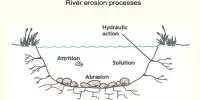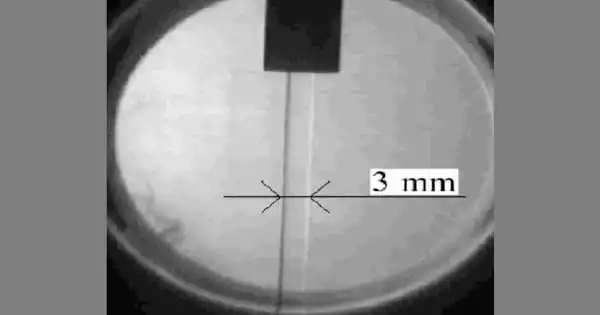Scientists have been enthralled by Europa’s deep saltwater ocean for decades as a leading candidate for life in our solar system. Its icy shell, which may be miles to tens of miles thick, surrounds it, making sampling it a difficult task.
The ice shell may no longer be a barrier, but rather a dynamic system and possible habitat in and of itself, according to mounting data. The emergence of a “double ridge” characteristic in Greenland was observed by ice-penetrating radar, which raises the possibility that the ice shell of Europa contains several water pockets beneath features comparable to those that are typical on the surface.
The research, which was published in Nature Communications on April 19, 2022, maybe convincing for identifying possibly habitable regions on the Jovian moon’s surface.
“Because it’s closer to the surface, where you get interesting chemicals from space, other moons, and the volcanoes of Io, there’s a possibility that life has a shot if there are pockets of water in the shell,” said study senior author Dustin Schroeder, an associate professor of geophysics at Stanford University’s School of Earth, Energy & Environmental Sciences (Stanford Earth). “If the mechanism we see in Greenland is how these things happen on Europa, it suggests there’s water everywhere.”
A terrestrial analog
On Earth, scientists use aerial geophysical instruments to study the polar areas in order to better understand how the expansion and contraction of ice sheets may affect sea level rise.
A large portion of the research region is on land, where the movement of ice sheets is influenced by complicated hydrology, including dynamic subglacial lakes, surface melt ponds, and seasonal drainage conduits. This hydrology adds uncertainty to estimates of sea level rise.
The co-authors of the study were taken aback when, during a lab group presentation about Europa, they observed that formations that streak the icy moon looked strikingly similar to a minor feature on the surface of the Greenland ice sheet, an ice sheet that the group has studied in detail. A land-based subsurface is so different from Europa’s subsurface ocean of liquid water.
“We were working on something totally different related to climate change and its impact on the surface of Greenland when we saw these tiny double ridges and we were able to see the ridges go from ‘not formed’ to ‘formed’?” Schroeder said.
Because it’s closer to the surface, where you get interesting chemicals from space, other moons, and the volcanoes of Io, there’s a possibility that life has a shot if there are pockets of water in the shell. If the mechanism we see in Greenland is how these things happen on Europa, it suggests there’s water everywhere.
Dustin Schroeder
Further investigation revealed that the “M”-shaped double ridge in Greenland might be a scaled-down replica of Europa’s most noticeable feature.
Prominent and prevalent
On Europa, two ridges stand out as striking gashes in the frozen surface, with crests reaching almost 1000 feet and valleys measuring roughly half a mile apart. Since the Galileo spacecraft took pictures of the moon’s surface in the 1990s, scientists have been aware of the features, but they have not been able to come up with a conclusive theory as to how they came to be.
Researchers discovered how the double ridge on northwest Greenland was created when the ice fractured around a pocket of pressurized liquid water that was refreezing inside of the ice sheet, causing two peaks to rise into a distinct shape. This information was obtained through analyses of surface elevation data and ice-penetrating radar collected from 2015 to 2017 by NASA’s Operation IceBridge.
“In Greenland, this double ridge formed in a place where water from surface lakes and streams frequently drains into the near-surface and refreezes,” said lead study author Riley Culberg, a Ph.D. student in electrical engineering at Stanford.
“One way that similar shallow water pockets could form on Europa might be through water from the subsurface ocean being forced up into the ice shell through fractures and that would suggest there could be a reasonable amount of exchange happening inside of the ice shell.”
Snowballing complexity
This discovery and others, including evidence of water plumes that erupt to the surface, support the hypothesis that Europa’s shell appears to undergo a range of geological and hydrological processes rather than acting like a block of inert ice.
Since it promotes the interchange between the deep ocean and nutrients from nearby celestial bodies deposited on the surface, a dynamic ice shell encourages habitability.
“People have been studying these double ridges for over 20 years now, but this is the first time we were actually able to watch something similar on Earth and see nature work out its magic,” said study co-author Gregor Steinbrügge, a planetary scientist at NASA’s Jet Propulsion Laboratory (JPL) who started working on the project as a postdoctoral researcher at Stanford.
“We are making a much bigger step into the direction of understanding what processes actually dominate the physics and the dynamics of Europa’s ice shell.”
The co-authors claimed that without the analog on Earth, they would not have been able to conceptualize their hypothesis for how the double ridges arise since it is so intricate.
“The mechanism we put forward in this paper would have been almost too audacious and complicated to propose without seeing it happen in Greenland,” Schroeder said.
The discoveries give scientists a radar signal for readily spotting this double ridge development process using ice-penetrating radar, one of the tools currently envisaged for investigating Europa from space.
“We are another hypothesis on top of many we just have the advantage that our hypothesis has some observations from the formation of a similar feature on Earth to back it up,” Culberg said. “It’s opening up all these new possibilities for a very exciting discovery.”
Schroeder is also a faculty affiliate with the Institute for Human-Centered Artificial Intelligence (HAI), an associate professor, by courtesy, of electrical engineering and a center fellow, by courtesy, at the Stanford Woods Institute for the Environment.
















